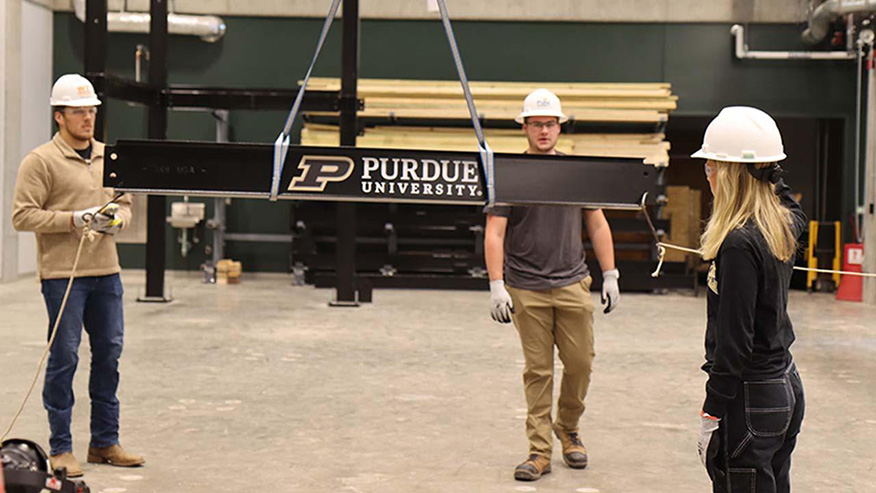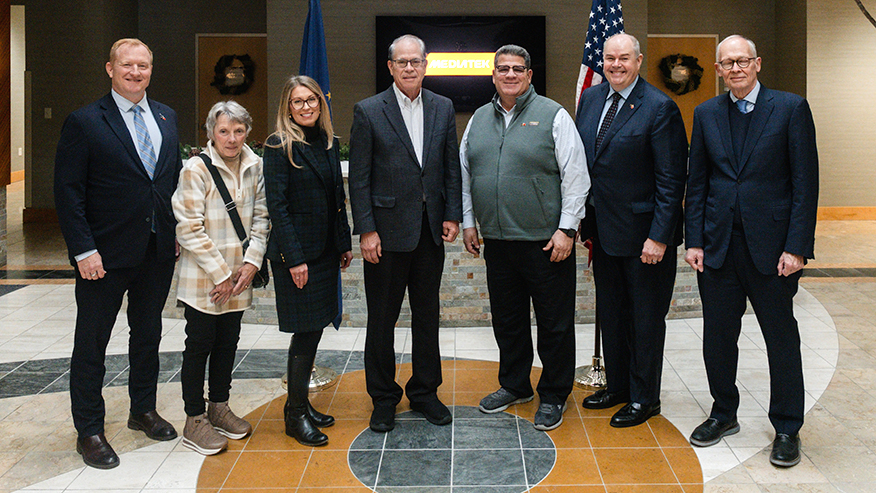Consumers see food prices as rising more than other goods and services, find ways to adapt
Affording food difficult for more than one-third of Gen Z and millennials

In the latest Consumer Food Insights Report, Joseph Balagtas, professor of agricultural economics at Purdue University and director of the Center for Food Demand Analysis and Sustainability, examines the rise in consumer diet satisfaction, looking at urban versus rural populations. (Purdue Agricultural Communications photo/Tom Campbell)
WEST LAFAYETTE, Ind. — More than 80% of consumers perceive that food prices have increased a little or a lot over the last 12 months, according to the May 2024 Consumer Food Insights Report (CFI).
The survey-based report out of Purdue University’s Center for Food Demand Analysis and Sustainability assesses food spending, consumer satisfaction and values, support of agricultural and food policies, and trust in information sources. Purdue experts conducted and evaluated the survey, which included 1,200 consumers across the U.S.
The Bureau of Labor Statistics’ consumer price index measure of food inflation shows a 12-month increase in food prices of 2.2%, down from 4.4% a year ago. “While food inflation has slowed in 2024, consumers are feeling the cumulative effect of the high inflation we’ve experienced,” said the report’s lead author, Joseph Balagtas, professor of agricultural economics at Purdue and director of CFDAS.
The May CFI survey asked consumers to report their experiences and responses to rising food prices over the last 12 months. The survey included a question asked previously in February and July 2022, seeing how consumers have adapted their grocery shopping in response to food price inflation.
HOW HAVE PRICES OF GOODS AND SERVICES CHANGED AND HOW DO THEY COMPARE TO PERCEPTIONS OF FOOD PRICES?

The researchers found that the most common shopping adaptations to food inflation are seeking out sales and discounts, switching to cheaper and generic brands, and buying fewer nonessential foods like ice cream.
“We also wanted to understand how perceived changes in food prices compare with perceived price changes for other common household expenses,” Balagtas said. “Consumers were more likely to report price increases for food than for any other good or service in the economy.”
Similarly, when asked which goods and services saw the largest year-over-year price increase, 56% of consumers selected “food,” despite official inflation data that show prices of insurance, housing and child care have risen faster than prices for food in the past year. “It’s possible the high frequency with which we shop for food could make higher food prices more salient to consumers. Media attention to food could also play a role,” Balagtas said.
The May survey revisited generational differences analyzed in past reports by categorizing consumers into Gen Z (born after 1996), millennials (born 1981-1996), Gen X (born 1965-1980), and boomer-plus (born before 1965).
“One area where we see bigger generational differences when asking about recent consumer experiences is the source of funding that consumers reported relying on to purchase food,” Balagtas said. “Around 37% of Gen Z and millennial consumers report drawing on savings or going into debt to finance their food purchases over the past year compared to 28% of Gen X and only 13% of boomer-plus consumers. It is concerning to see over a third of young adults needing to stretch their finances to afford food.”
Food insecurity is highest among Gen Z adults, with around one-third of consumers from this group also reporting having trouble accessing quality food. This is much higher than the rate of food insecurity among older Gen X (13%) and boomer-plus (5%) consumers.
“More research is needed, but these results are likely driven in part by a stage-of-life effect, as income and wealth increase are drivers of food security and tend to increase with age,” Balagtas said.
HOW ARE HIGHER FOOD PRICES CHANGING AMERICAN SPENDING BEHAVIORS?

The April consumer price index measure of food price inflation — the most recent available — remained unchanged from March at 2.2%. The inflation rate seems to have stabilized, having stayed around 2.2% for the last three months, noted Elijah Bryant, a survey research analyst at CFDAS and co-author of the report.
“According to the center’s data, consumer estimates of food inflation over the past year of 6.2% and expectations for the coming year of 3.6% continue to remain higher than the CPI estimate,” Bryant said. This suggests that consumer experiences with food prices have been different than the official measurement.
“Consumers’ inflation estimates continue to hover around 6%, showing that the dramatic increase in food inflation in previous years may still be affecting consumer food price sentiment. However, consumers have been consistently more optimistic about future food prices relative to their inflation estimates over the past 12 months,” Bryant said.
Consumers are asked to allocate 100 points among the six attributes — taste, affordability, nutrition, availability, environmental impact and social responsibility — based on the importance of each in their grocery purchasing decisions. Though CFDAS began measuring food values on a quarterly basis in January 2024, the researchers have yet to observe significant changes in the importance level of these attributes.
About Purdue University
Purdue University is a public research institution demonstrating excellence at scale. Ranked among top 10 public universities and with two colleges in the top four in the United States, Purdue discovers and disseminates knowledge with a quality and at a scale second to none. More than 105,000 students study at Purdue across modalities and locations, including nearly 50,000 in person on the West Lafayette campus. Committed to affordability and accessibility, Purdue’s main campus has frozen tuition 13 years in a row. See how Purdue never stops in the persistent pursuit of the next giant leap — including its first comprehensive urban campus in Indianapolis, the Mitchell E. Daniels, Jr. School of Business, Purdue Computes and the One Health initiative — at https://www.purdue.edu/president/strategic-initiatives.
Writer: Steve Koppes
Media contact: Devyn Raver, draver@purdue.edu
Sources: Joseph Balagtas, balagtas@purdue.edu; Elijah Bryant, ehbryant@purdue.edu.
Agricultural Communications: 765-494-8415;
Maureen Manier, Department Head, mmanier@purdue.edu
Note to journalists:



